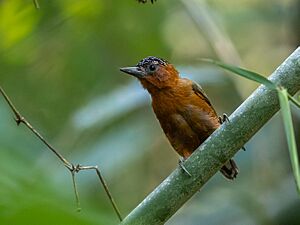Rufous-breasted piculet facts for kids
Quick facts for kids Rufous-breasted piculet |
|
|---|---|
 |
|
| female | |
| Conservation status | |
| Scientific classification | |
| Genus: |
Picumnus
|
| Species: |
rufiventris
|
 |
|
The rufous-breasted piculet (Picumnus rufiventris) is a small bird that belongs to the woodpecker family. It's found in several South American countries like Bolivia, Brazil, Colombia, Ecuador, and Peru. These tiny birds are known for their bright colors and how they search for food.
Contents
About the Rufous-Breasted Piculet
Birds sometimes have slightly different groups called subspecies. The rufous-breasted piculet has three of these. They are P. r. rufiventris, P. r. grandis, and P. r. brunneifrons. These groups look a bit different or live in different places.
What Does It Look Like?
The rufous-breasted piculet is a small bird, about 9 to 11 centimeters (3.5 to 4.3 inches) long. It weighs between 12 and 21 grams (0.4 to 0.7 ounces).
Male and Female Birds
Adult male piculets have a black cap on their head. Many of these black feathers have bright red tips. They also have small white or light brown spots on the sides and back of their cap. Their face, neck, and belly are a rich orange-red or reddish-brown color. Their back is a yellowish-olive color. Their tail is black, but the feathers closest to their body have white inside and light brown tips. The outer tail feathers have a wide light brown stripe.
Adult female piculets look very similar to males. The main difference is that females have white dots all over their black cap instead of red tips.
Young Birds
Young piculets, called juveniles, are not as brightly colored as adult birds. Their cap is brown, and the feathers have narrow light brown edges.
Different Subspecies
The subspecies P. r. grandis is about 15% larger than the main group. It looks more yellowish on its back and paler on its belly. Its black cap is smaller, with more red towards the back and white spots on the front.
The subspecies P. r. brunneifrons is in between the other two in size. Its cap pattern is similar to grandis but darker. The reddish color on its neck is wider than in the main group.
Where Do They Live?
The main group of rufous-breasted piculets lives in southeastern Colombia, eastern Ecuador, western Brazil, and northern Peru. The P. r. grandis subspecies is found in central and southern Peru. The P. r. brunneifrons subspecies lives in northwestern and central Bolivia.
These birds mostly live near rivers. They prefer the thick plants and bamboo that grow right next to the water. You might also find them at the edges of other forests, along roads with dense plants, or even in small gardens.
How Do They Behave?
Feeding Habits
Rufous-breasted piculets usually look for food close to the ground, often within 3 meters (10 feet) up. They often search alone or in pairs. Sometimes, they join groups of different bird species that are also looking for food.
They cling to bamboo stalks and small branches, sometimes even hanging upside down! They peck and poke at the bark to find food. We don't know all the details of their diet, but we do know they eat insects.
Reproduction and Life Cycle
Rufous-breasted piculets breed between January and March in Bolivia and Peru. They seem to breed a bit later in Ecuador. Not much else is known about how they raise their young.
What Do They Sound Like?
The song of the rufous-breasted piculet is a slow, high-pitched sound. It usually has two notes that go down, like "seep seep." When they are flying, their calls are quick single "seep" notes or a fast "tsit tsit."
Conservation Status
The IUCN (International Union for Conservation of Nature) has said that the rufous-breasted piculet is a species of "Least Concern." This means they are not currently in danger of disappearing. They live across a very large area. Even though we don't know their exact population size, it seems to be stable.
There are no immediate threats to these birds. They are considered uncommon in some places and fairly common in others. Human activities don't have a big short-term effect on them, except for local destruction of their habitat.


